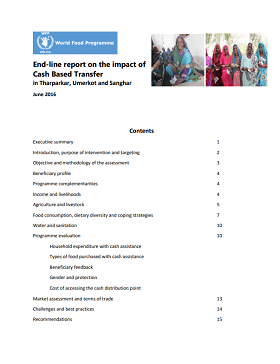End-line report on the impact of Cash Based Transfer in Tharparkar, Umerkot and Sanghar
The Food for Assets through Cashed Based Transfers was implemented in three drought affected districts of Sindh namely Tharparkar, Umerkot and Sanghar during the period from July 2015 to January 2016 covering 17,000 beneficiaries. The programme engaged beneficiary households in Cash for Training activities where they were paid PKR 5400 per cycle (for 4 cycles in total) for attending specified trainings on a range of themes based on the community needs. Apart from regular monitoring, two assessments baseline and end-line have been carried out which revealed following results:
- Majority of Households are headed by men and only 9.6% of households were found to be female headed.
- Unskilled wage Labour is the most important source of income in Tharparkar and Umerkot whereas livestock forms a much larger component of livelihood in Sanghar.
- 68.3% of households are found to cultivate land, of which 41.1% were found to be sharecroppers.
- The most commonly grown crops are bajra and guar and own production is sufficient to meet the household consumption needs for only 2.9 months in aveage.
- 94% of households owned livestock with most households in possession of small ruminants. The average ownership of goats and sheep was 8.3 per household whereas the ownership of all other animals averaged out to less than 1. The largest animal herds were found in Sanghar much higher than in Tharparkar and Umerkot.
- There was a marked improvement in the Food Consumption of assessed households from the baseline to the end-line. At the time of the baseline 15.4% had poor consumption, the proportion fell to only 4.1%. The percentage of households with “Acceptable” consumption rose significantly from 36.8% to 63.6%.
- As a result, the proportion of households who had to resort to coping strategies also dropped significantly. For instance, the proportion of households relying on less preferred or less expensive food decreased from 46.1% during baseline to 15.1% during end line.
- Two thirds of the cash received was spent on food by the surveyed households.
- Most Households found the training on Nutrition health and hygiene to be the most useful.
- Among the training messages delivered, the highest retention was related to handwashing with soap for which 71.4% of beneficiaries remembered all the messages from the training. The lowest complete retention was of messages on “types of water contamination and its impact on health” which only 39.5% of beneficiaries remembered.



